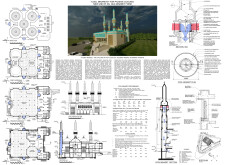5 key facts about this project
## Project Overview
Located in Gulberg Greens, Islamabad, Pakistan, the Ayesha Mosque exemplifies a contemporary approach to mosque architecture through its innovative passive cooling techniques. This design reinterprets the traditional minaret, blending cultural significance with modern needs. The mosque incorporates strategies aimed at improving airflow and natural cooling, addressing the climatic challenges of the region.
### Passive Cooling Mechanism
The design centers on the minaret's function as a passive cooling element. By leveraging natural ventilation principles, these structures facilitate airflow, thereby reducing dependence on mechanical cooling systems. This approach emphasizes not only functionality but also the aesthetic and spiritual elements inherent in Islamic design. The layout fosters community interaction through open spaces that encourage social gatherings and tranquility.
### Material Selection and Sustainability
A diverse array of materials has been employed thoughtfully to enhance both function and visual appeal. Steel is utilized for structural integrity, while Glass Fiber Reinforced Concrete (GFRC) provides a modern facade that mimics traditional stone. Other materials include Reinforced Concrete for stability, ceramic tiles for decorative purposes, and wood to add warmth to communal areas.
The mosque adheres to sustainable architectural principles by minimizing energy consumption through passive solar design. This results in an interior climate that prioritizes thermal comfort without mechanical ventilation. The thoughtful integration of traditional forms within a contemporary context supports cultural resonance while promoting eco-friendly practices, establishing the mosque as a forward-thinking model in architectural design.



















































